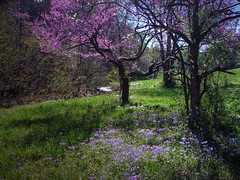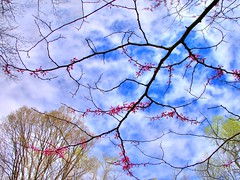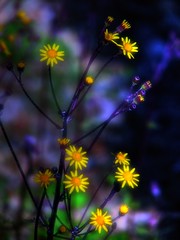The Mayapple in April

Image: Mayapple (Podophyllum peltatum) by D L Ennis
Podophyllum peltatum is most commonly known as the mayapple, but in various regions it is also known as Devil's apple, hog apple, Indian apple, umbrella plant, wild lemon, and American mandrake (though it should not be confused with true mandrake, Mandragora officinarum, an unrelated Old World plant whose roots have been used throughout history for medicines and potions.)
The Mayapple is a perennial plant in the barberry family (Berberidaceae) which is found in woodlands in Canada and the Eastern U.S. (Eastern being East of Oklahoma). These plants reach 6-18 inches in height and grow in patches. Each plant has a single stalk topped with one or two broad, deeply divided leaves that vaguely resemble umbrellas. The two-leaved plants normally produce a single, small white flower (usually in May, thus the name) from the fork in the stem. The flower develops into a pulpy, lemon-yellow berry which ripens in late summer and is the only part of the plant that isn't poisonous (however, the berries should only be eaten in moderation, if at all.)
The plant's long, thin rhizome (a horizontal underground stem from which the roots grow) is the most poisonous part, but also the most useful because it contains high concentrations of the compounds podophyllotoxin and alpha and beta peltatin, all of which have anticancer properties. Two closely-related Asian species, P. emodi and P. pleianthum, contain these active ingredients in lesser quantities as well as an alkaloid called berberine which can be used to treat fevers (especially malaria) and as an antibiotic.
The rhizomes have a long history as a medicine among Native North American tribes. They used to gather the rhizomes in the autumn and dry them and grind them to a powder. They would eat or drink a brew of the powder as a laxative or to get rid of intestinal worms. The powder was also used as a poultice to treat warts and tumorous growths on the skin.
Currently, extracts of the plant are used in topical medications for genital warts and some skin cancers. In China and Japan, the rhizomes of P. pleianthum are used to make a compound called Hakkakuren, which is used to treat snakebites and tumors of the genitals.
The purgative action of Mayapple rhizome powder is very strong, and the compounds in it are much too toxic to attempt self-medication with this plant.
The FDA rates the use of this plant as "unsafe."
Technorati Tags: [Blue Ridge][Mayapple][Wildflowers]























